Abstract
Several central depressant and other drugs have been examined for their effects upon acetylcholine release from the stimulated, perfused cat superior cervical ganglion and rat isolated phrenic nerve-diaphragm preparations. The acetylcholine released was assayed biologically. Amylobarbitone sodium, chloral hydrate, trichloroethanol, methylpentynol, methylpentynol carbamate, paraldehyde, procaine hydrochloride and troxidone reduced the presynaptic release of acetylcholine from the ganglion. They also exhibited a postsynaptic blocking action, this component of depressant activity being particularly prominent with paraldehyde and troxidone. Closely analogous findings were obtained at the neuromuscular junction with methylpentynol and its carbamate, paraldehyde, procaine hydrochloride, trichloroethanol and troxidone. At both sites the drug-induced depression, both of transmission and of acetylcholine output, was reversible. Whereas hexamethonium regularly blocked ganglionic transmission with no effect upon acetylcholine release, tetraethylammonium not only completely blocked ganglionic transmission but concomitantly augmented acetylcholine output. These results are discussed in relation to the electrophysiological and metabolic events associated with neuro-effector transmission.
Full text
PDF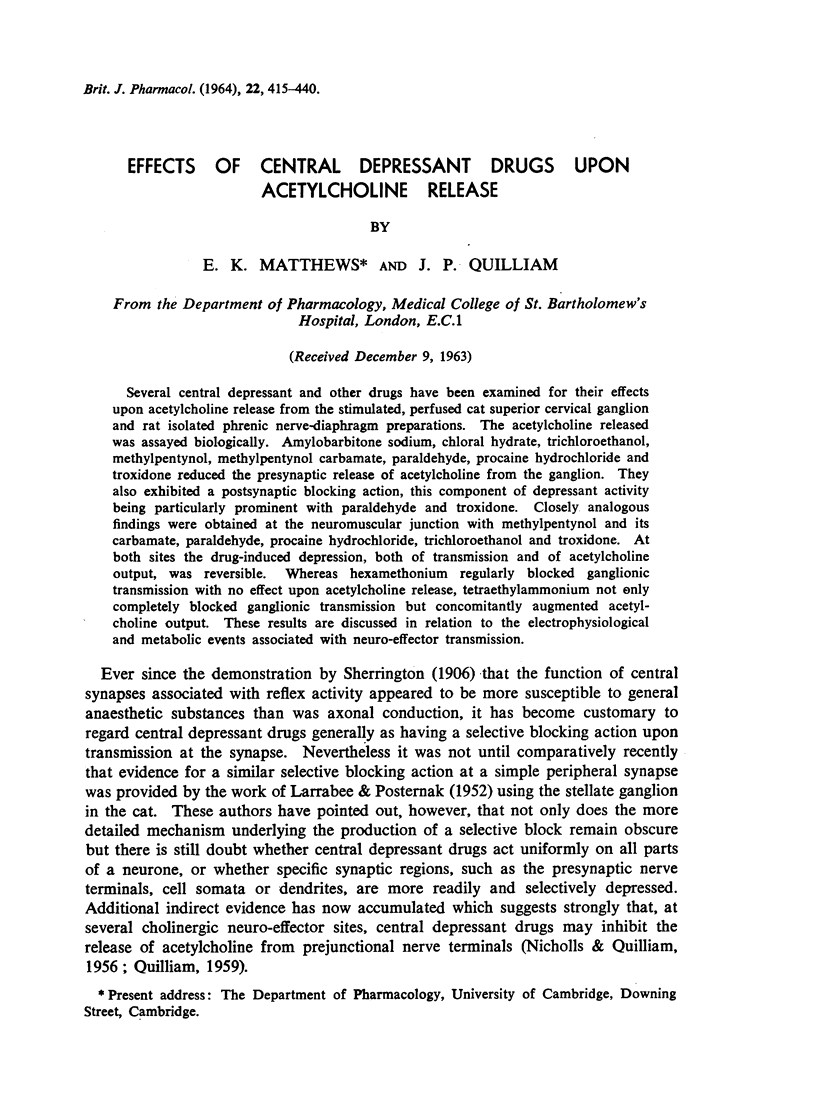
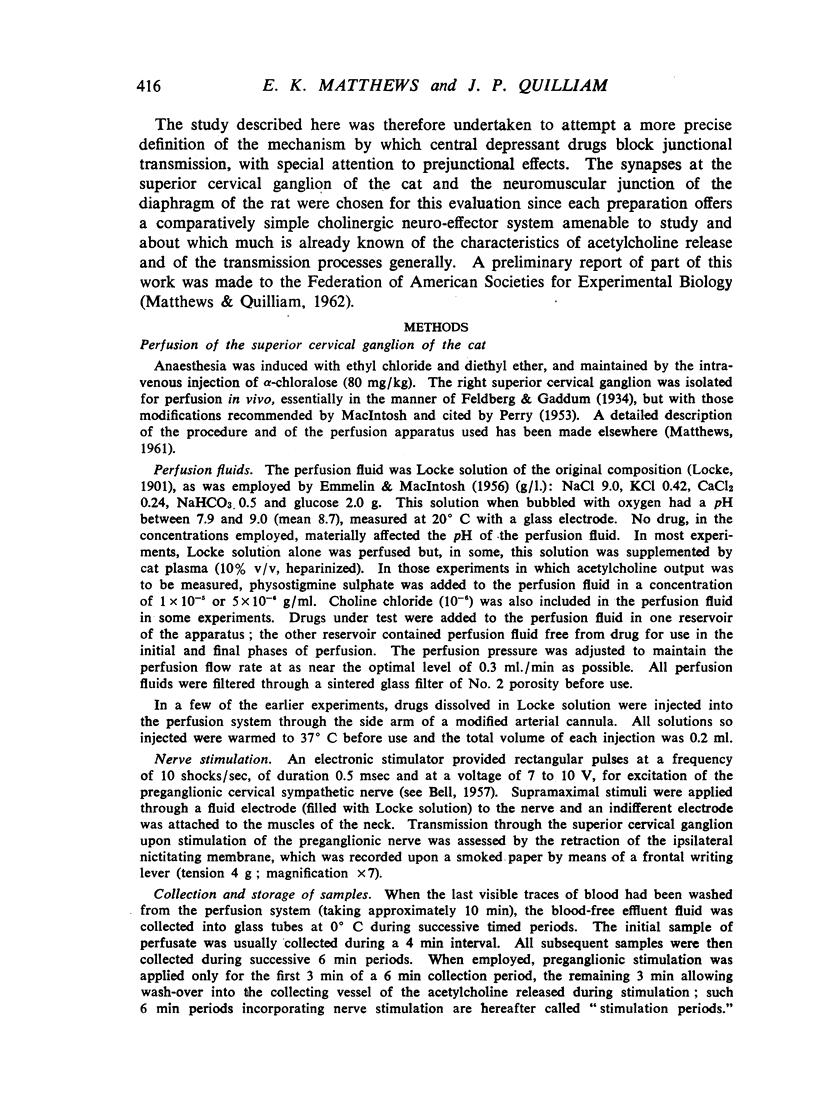
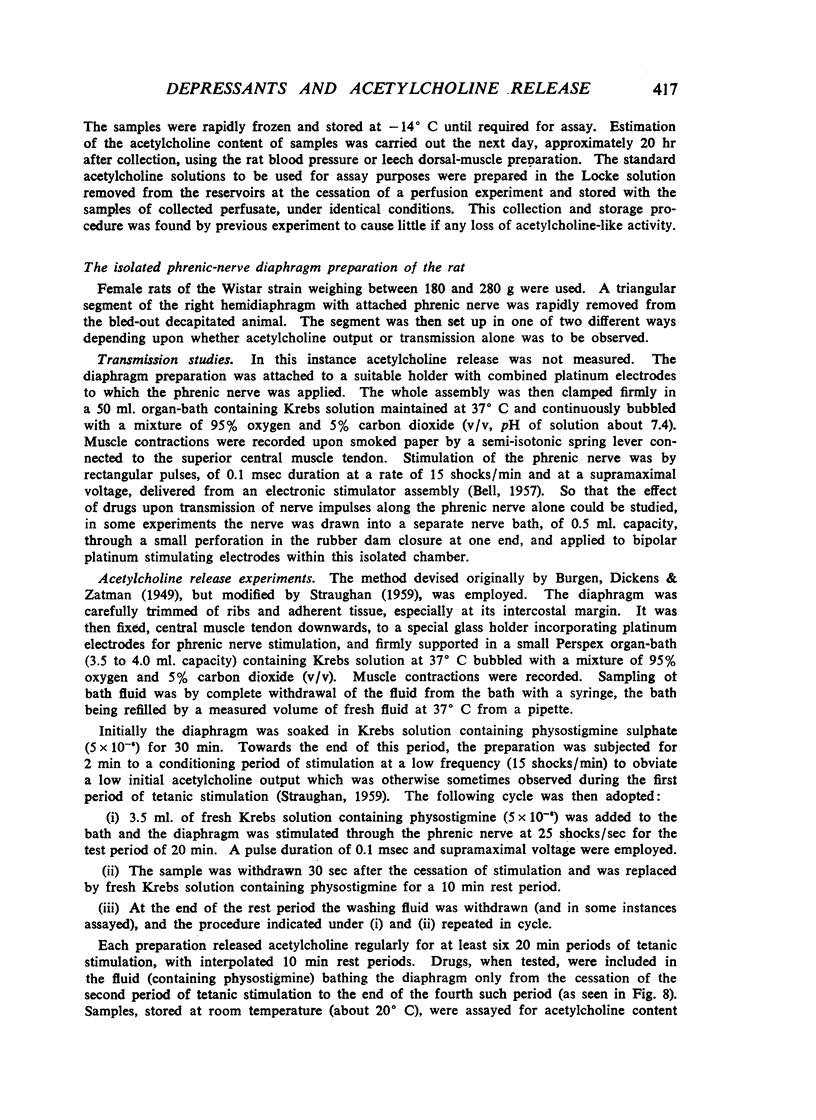
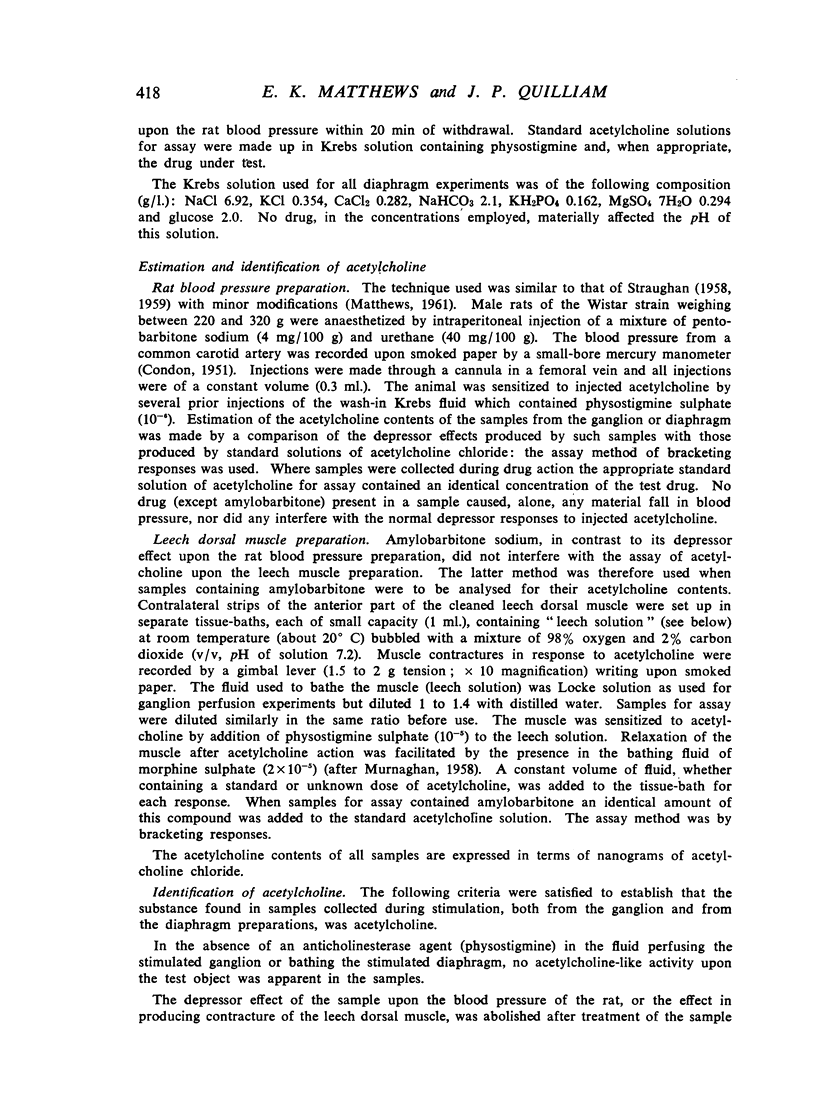
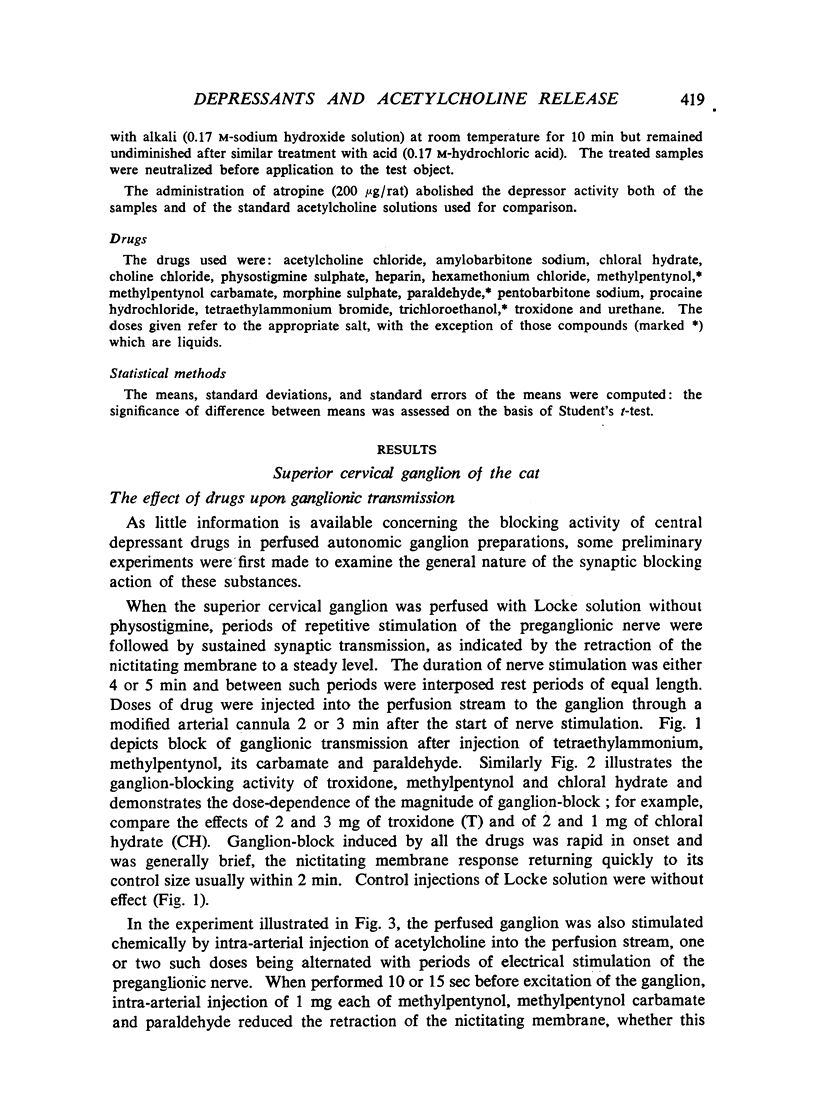
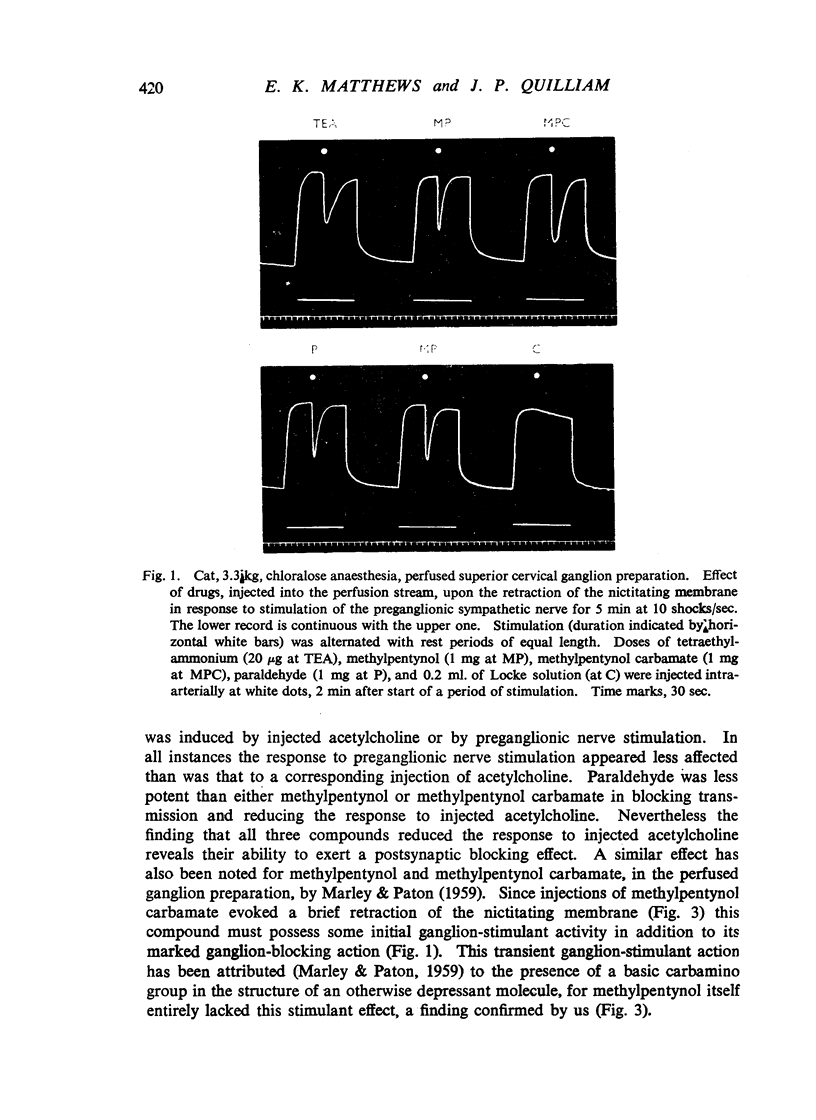
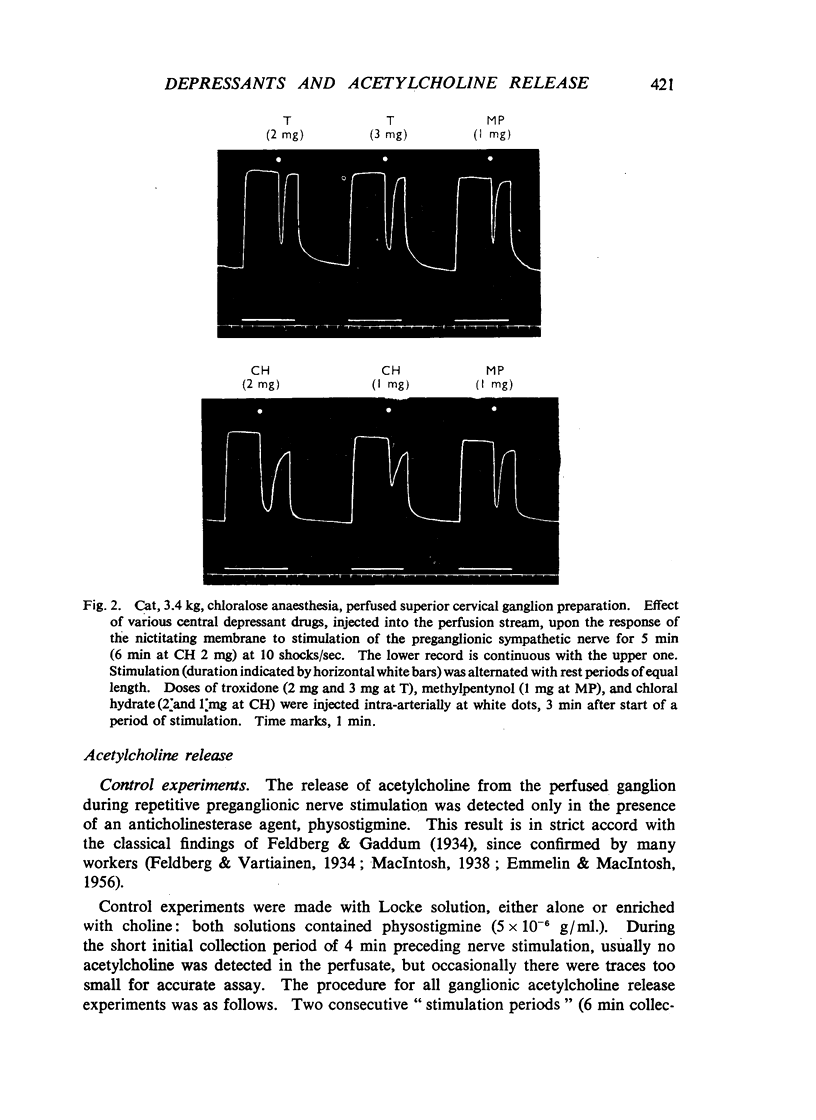
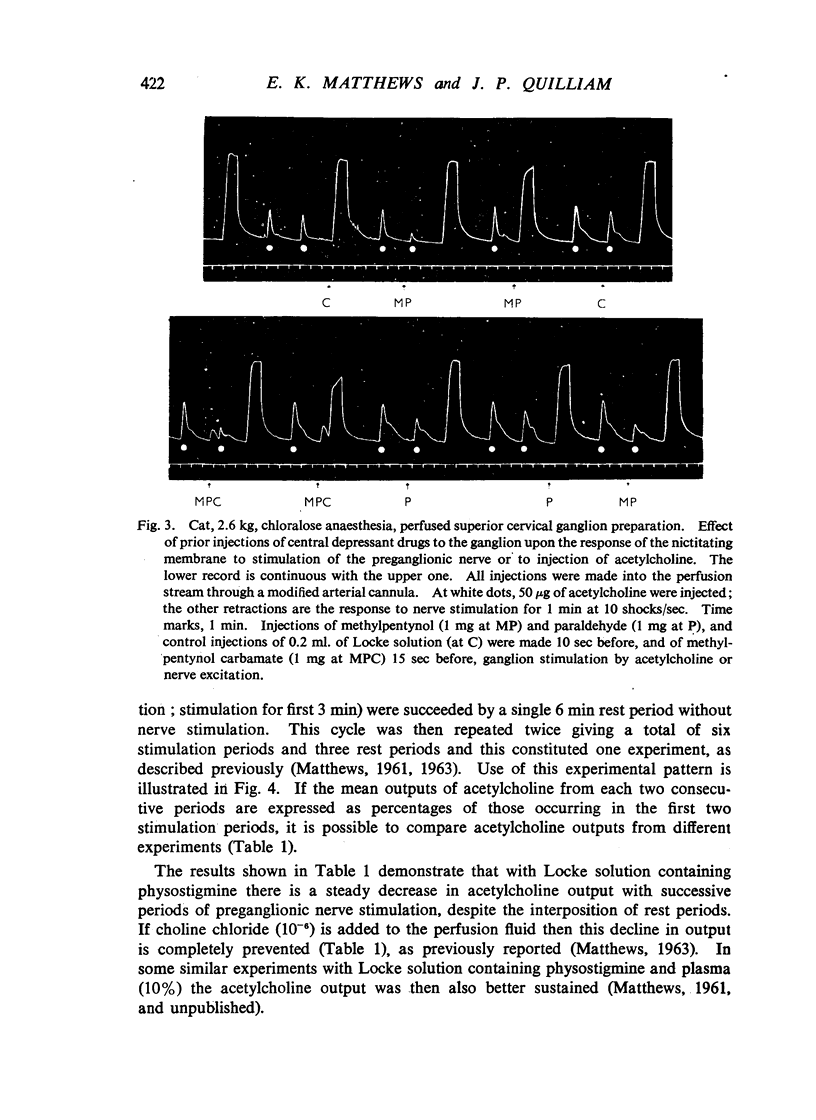
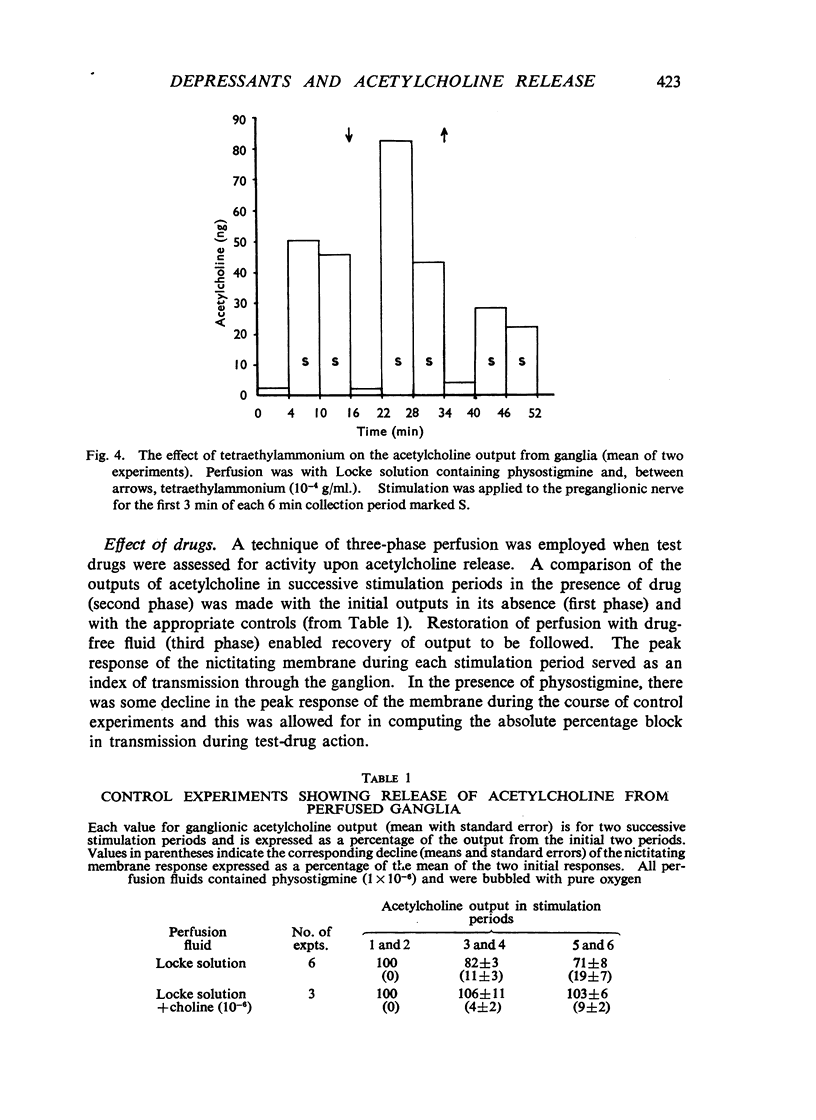

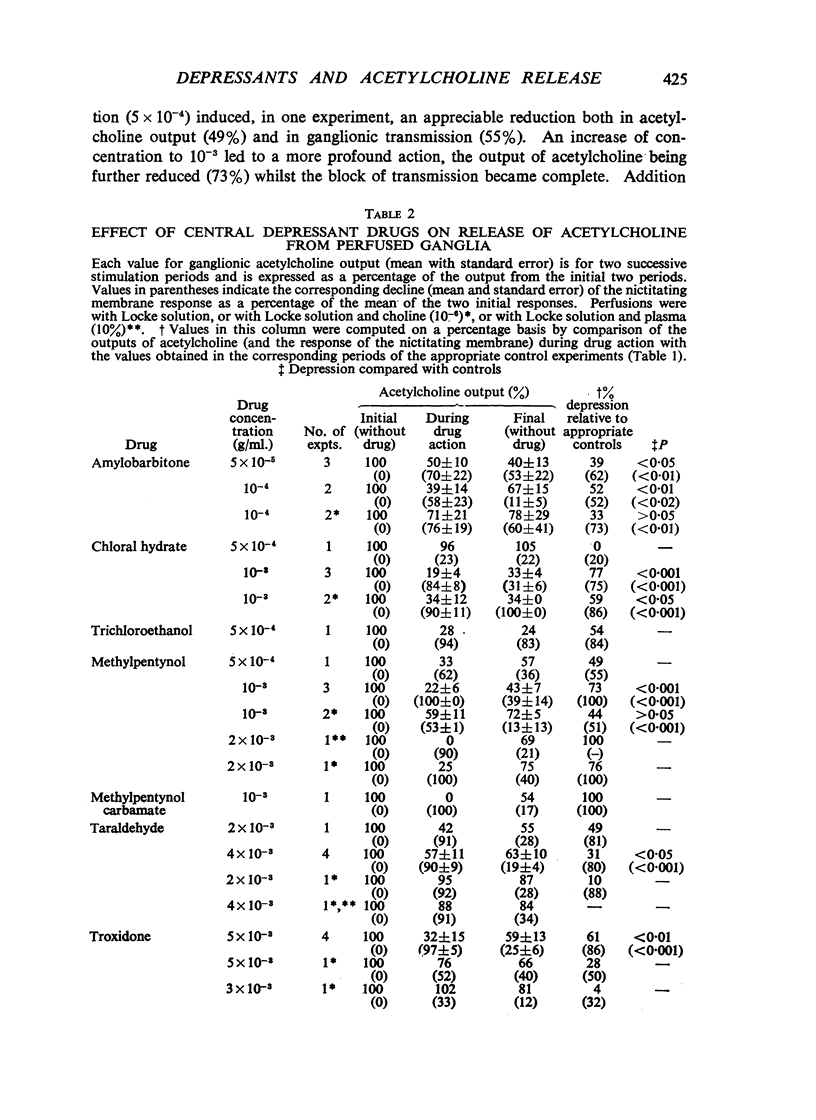
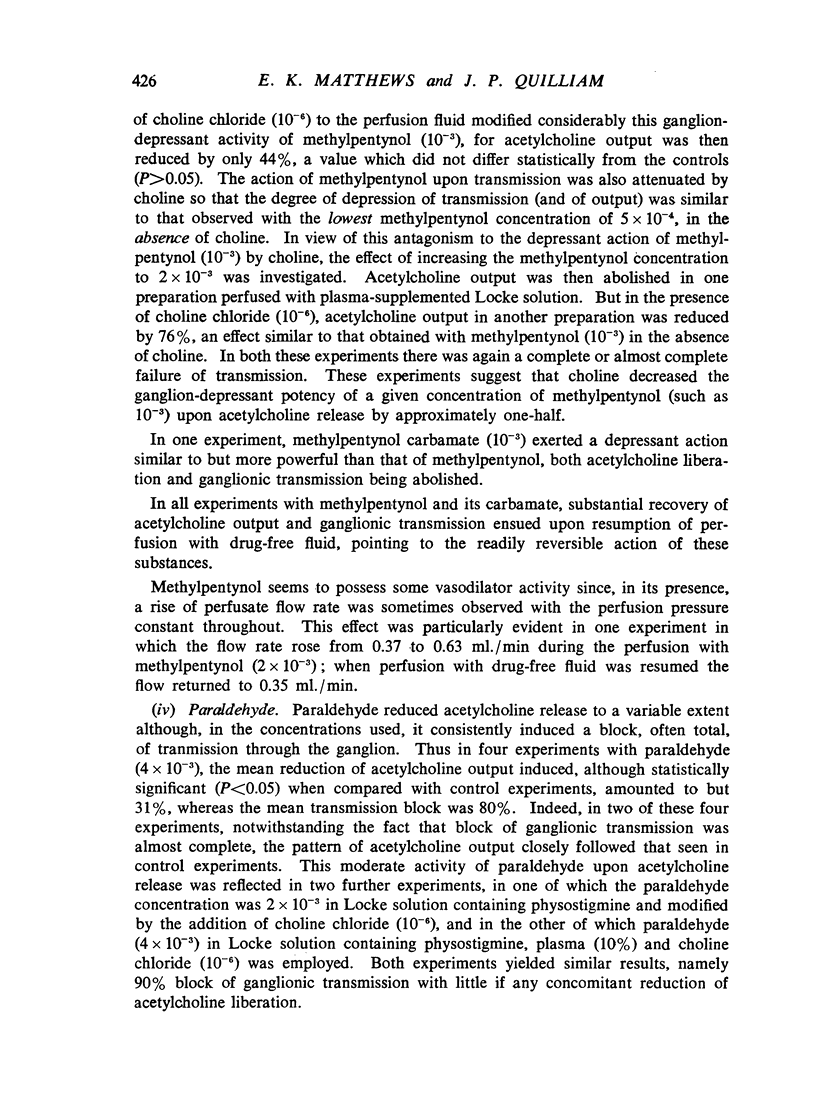
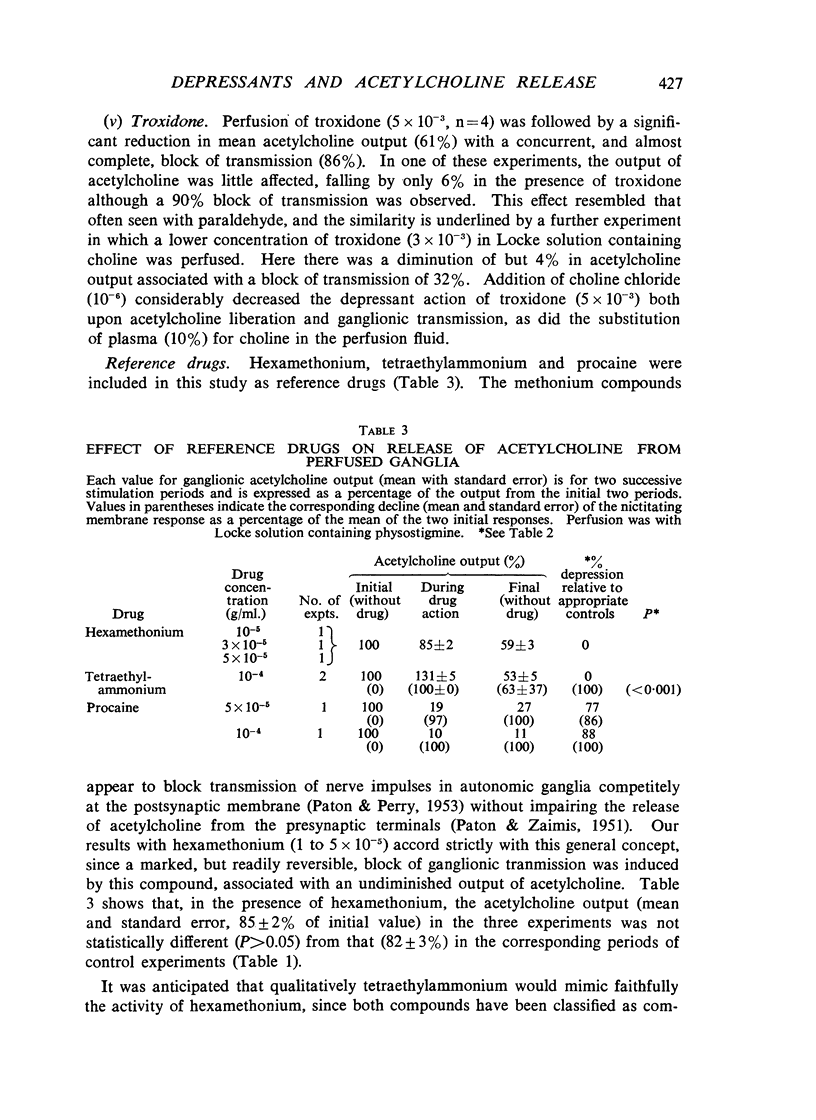
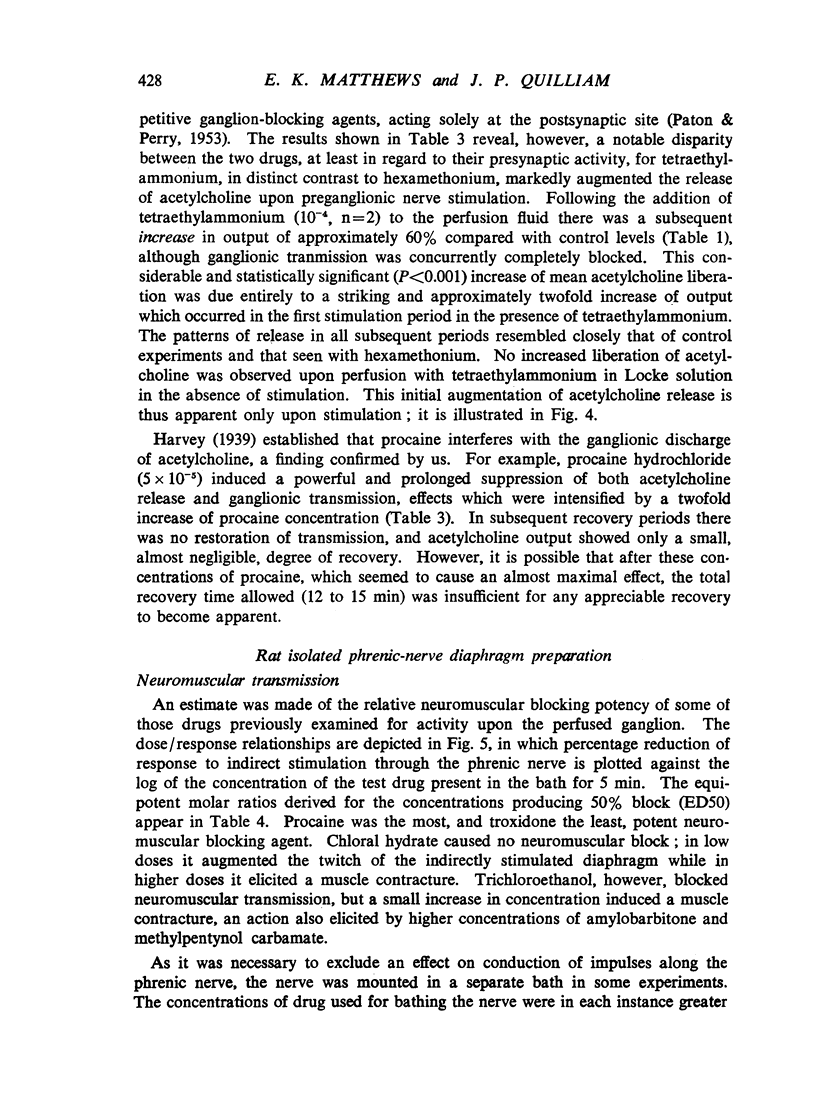
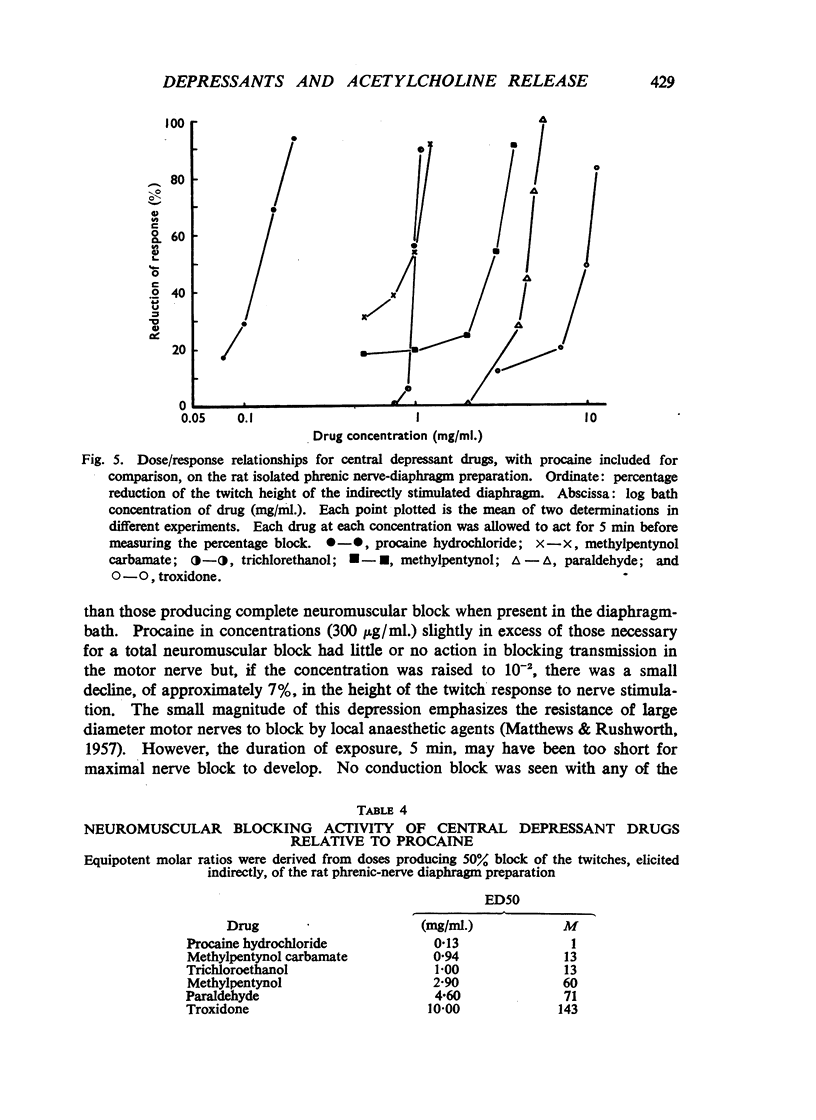
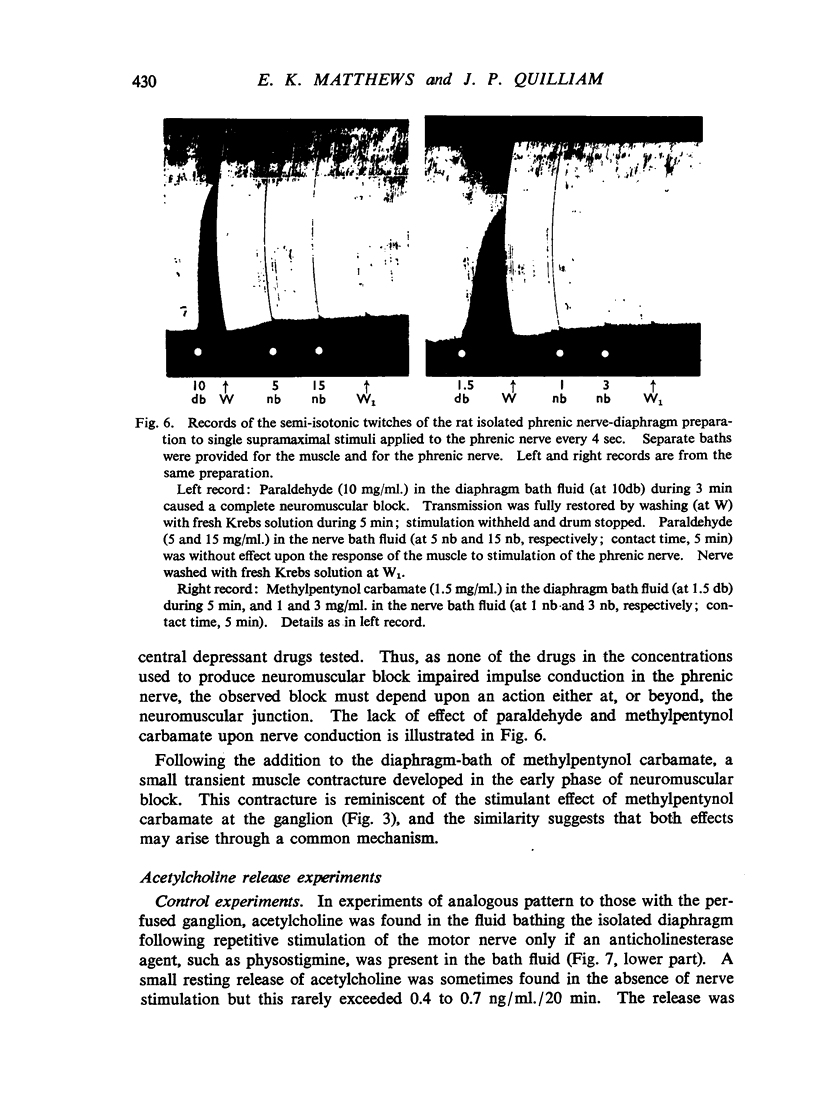
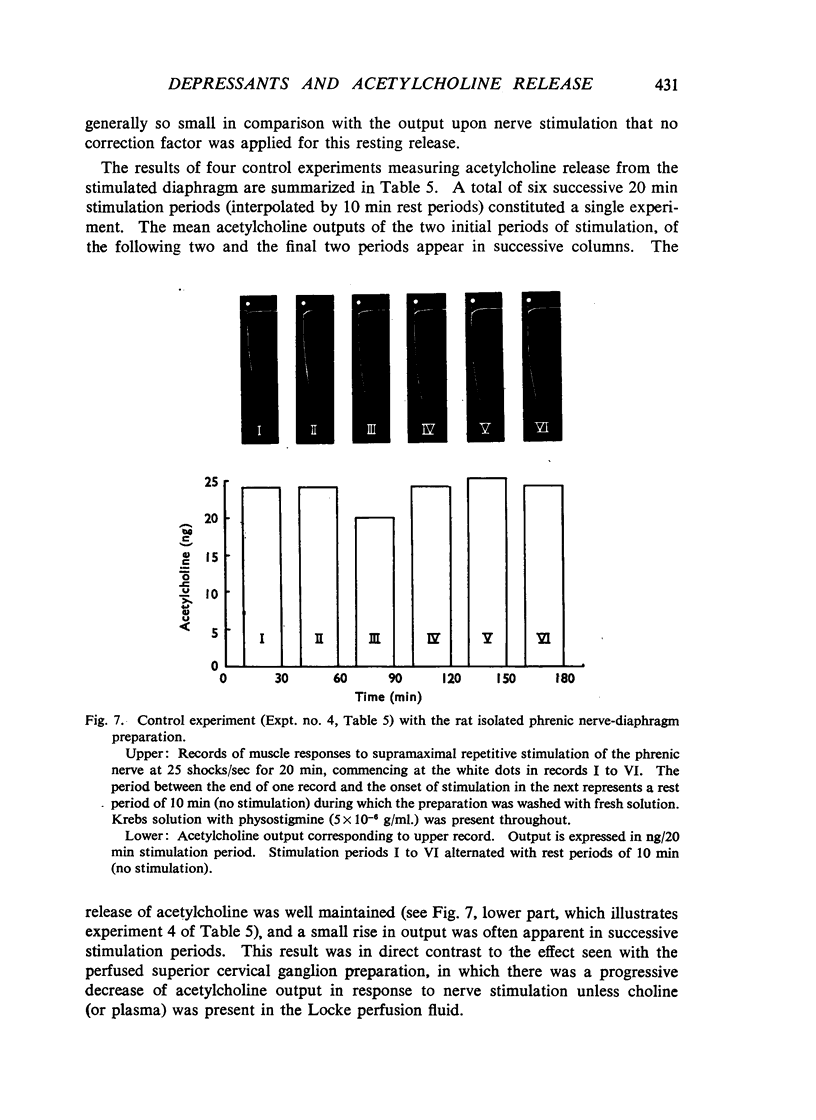
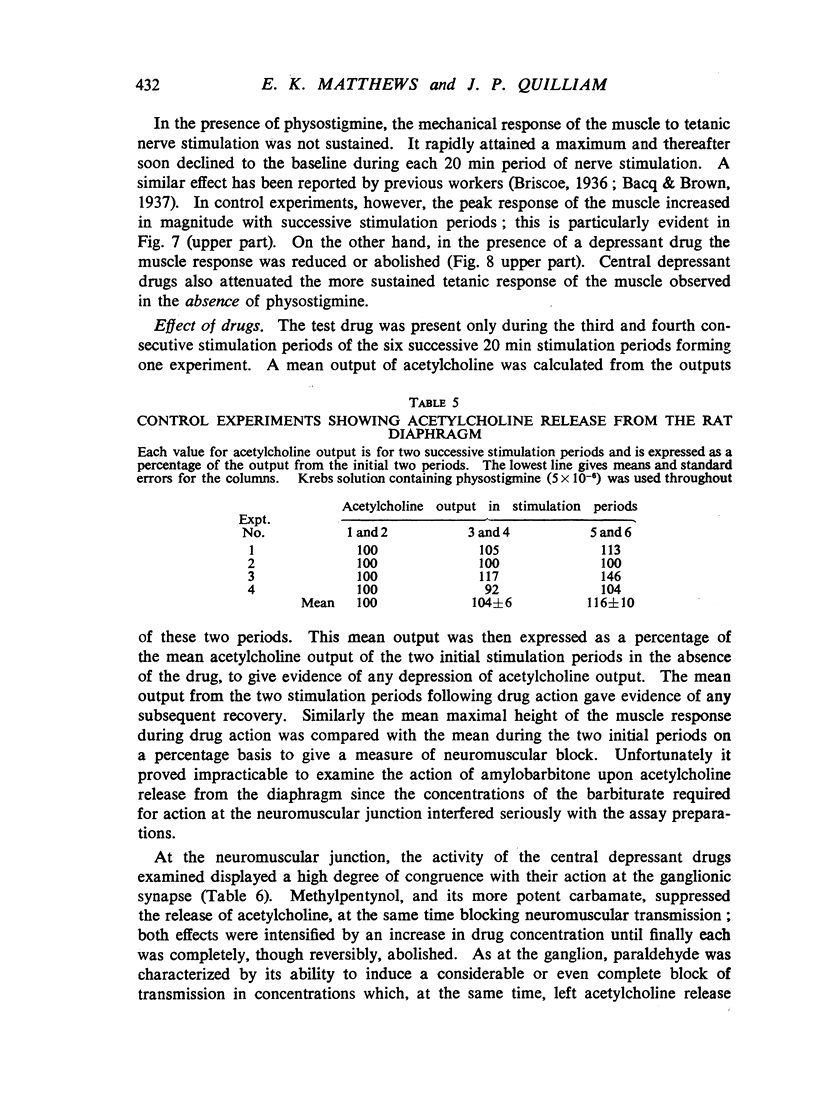
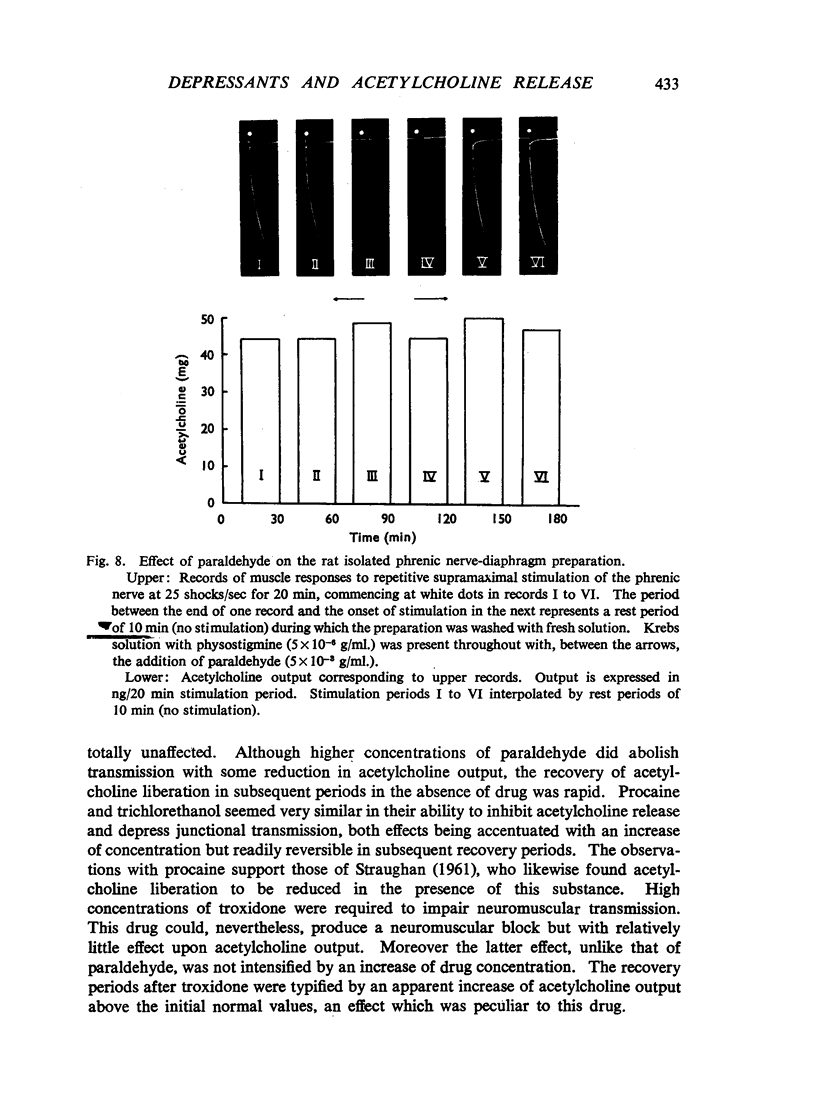
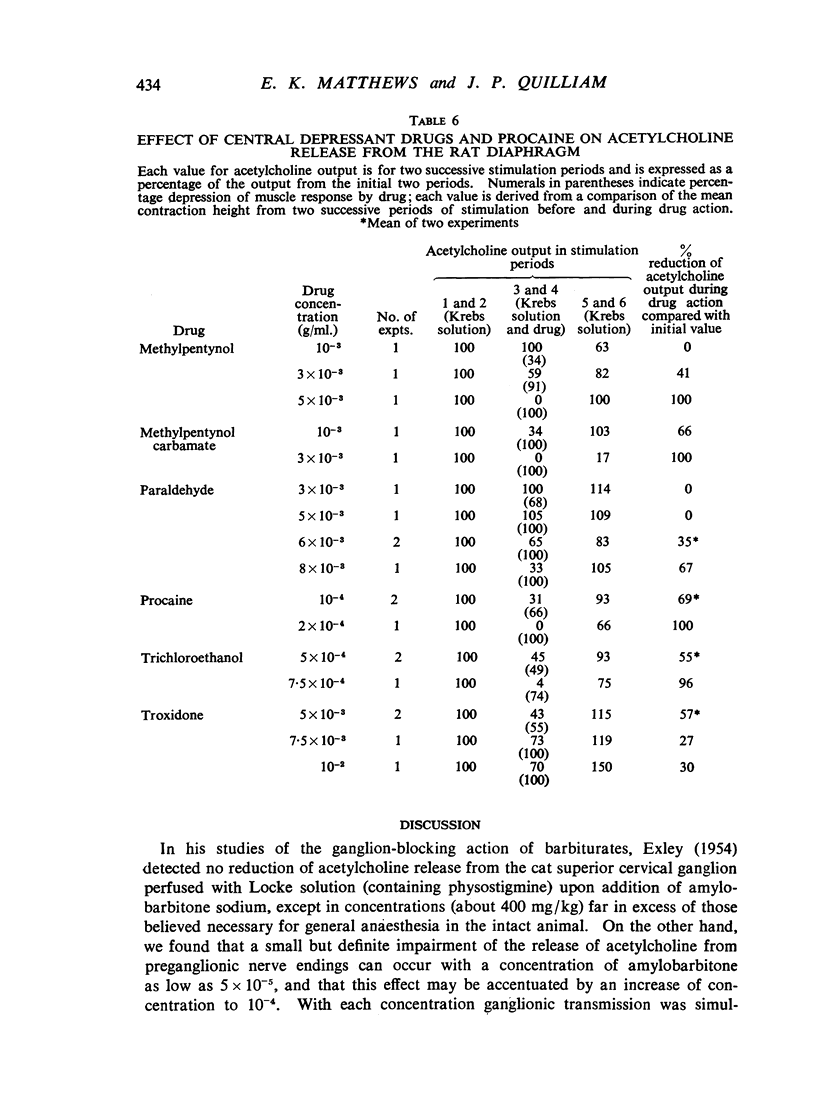
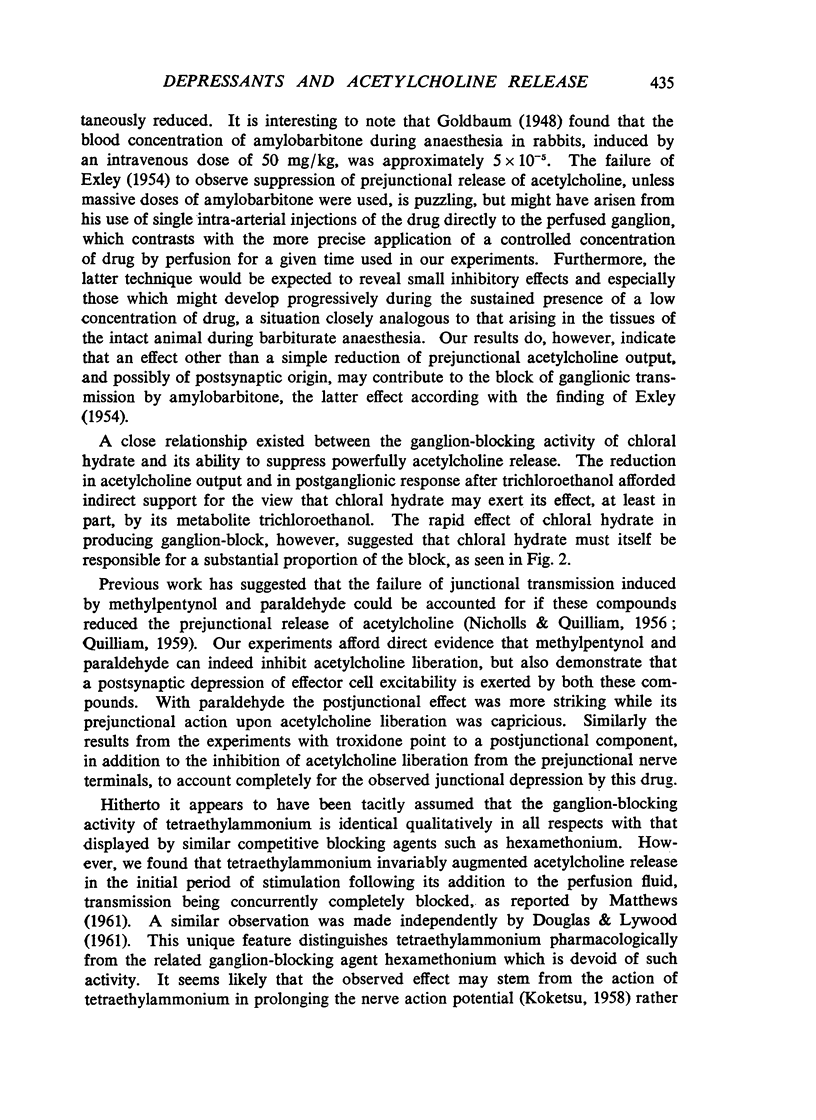
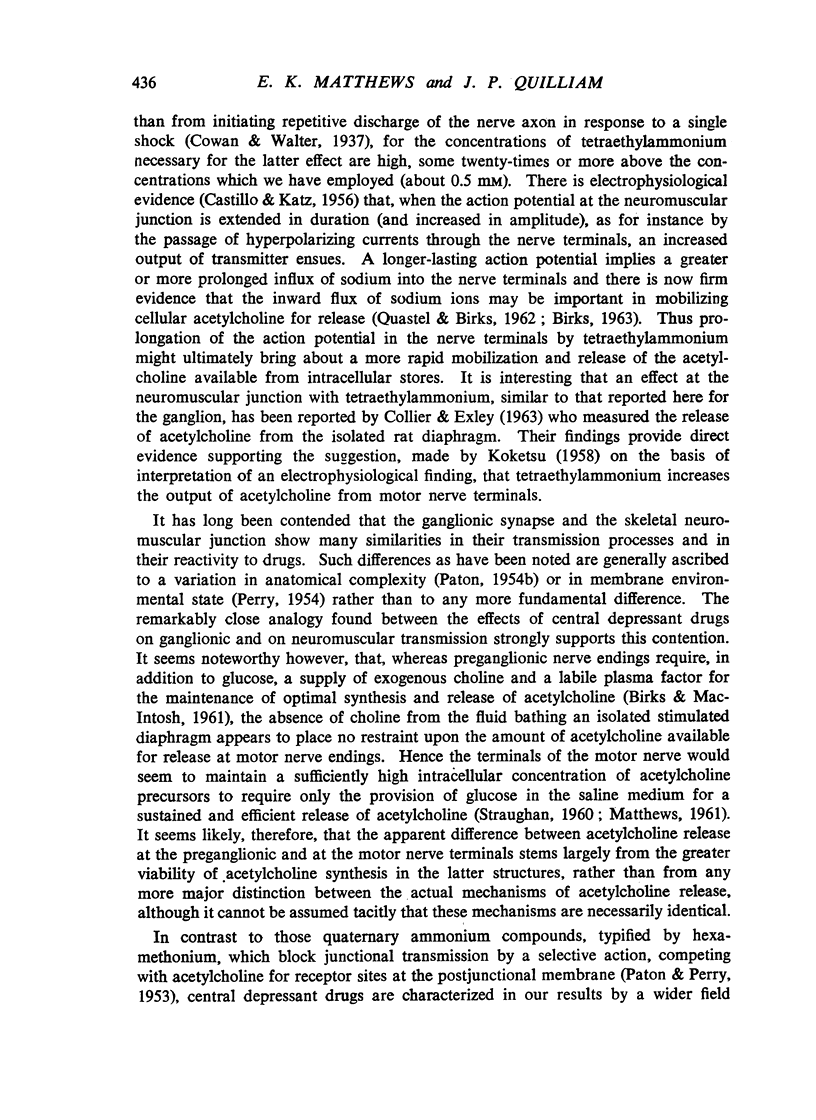
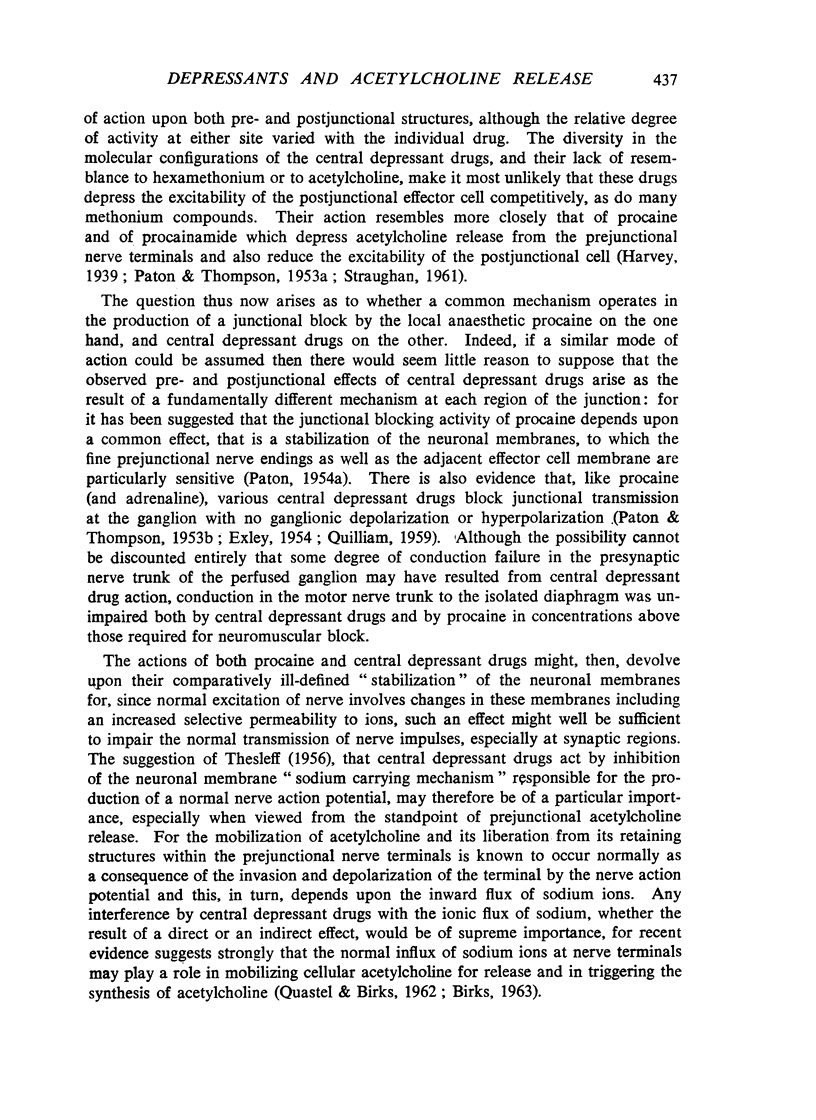
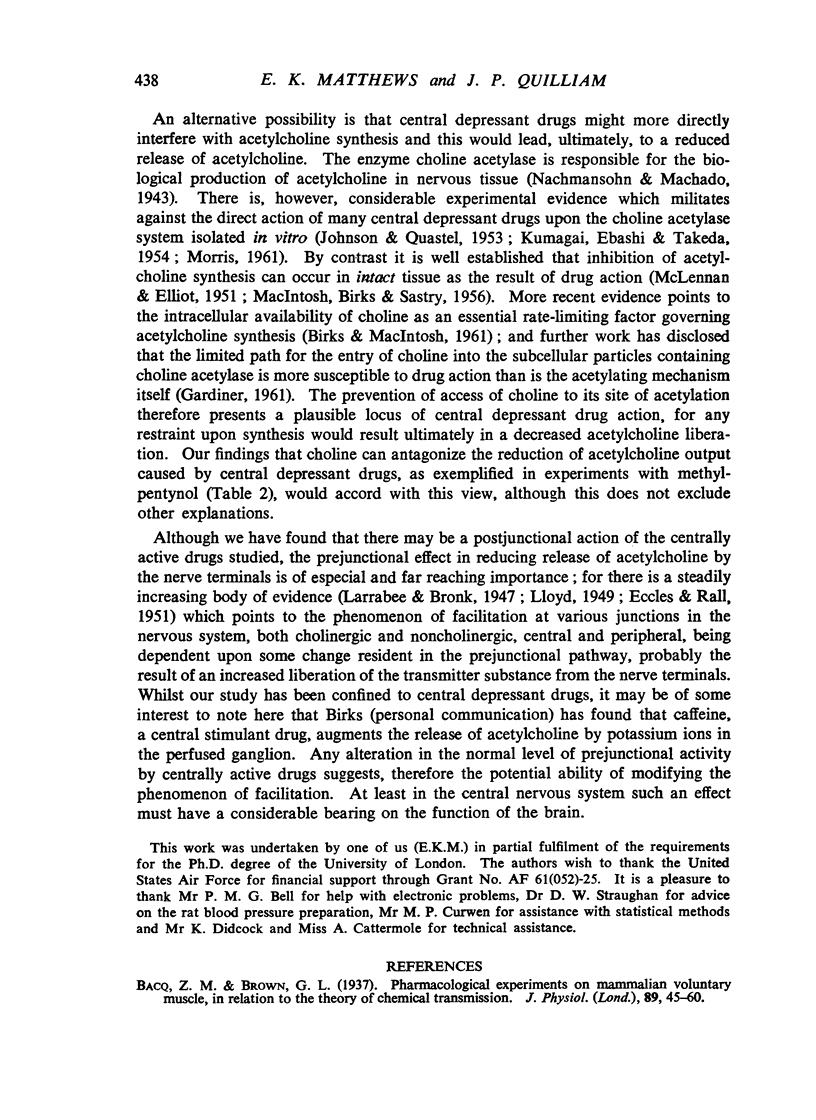
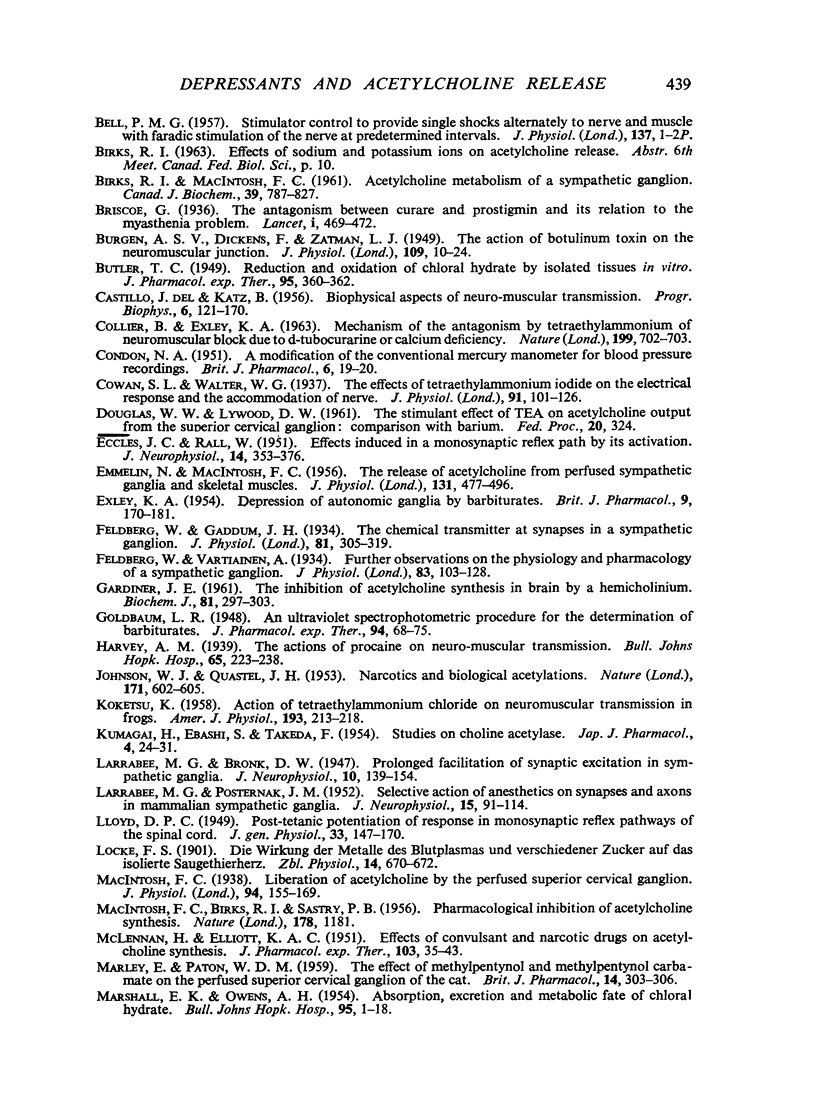
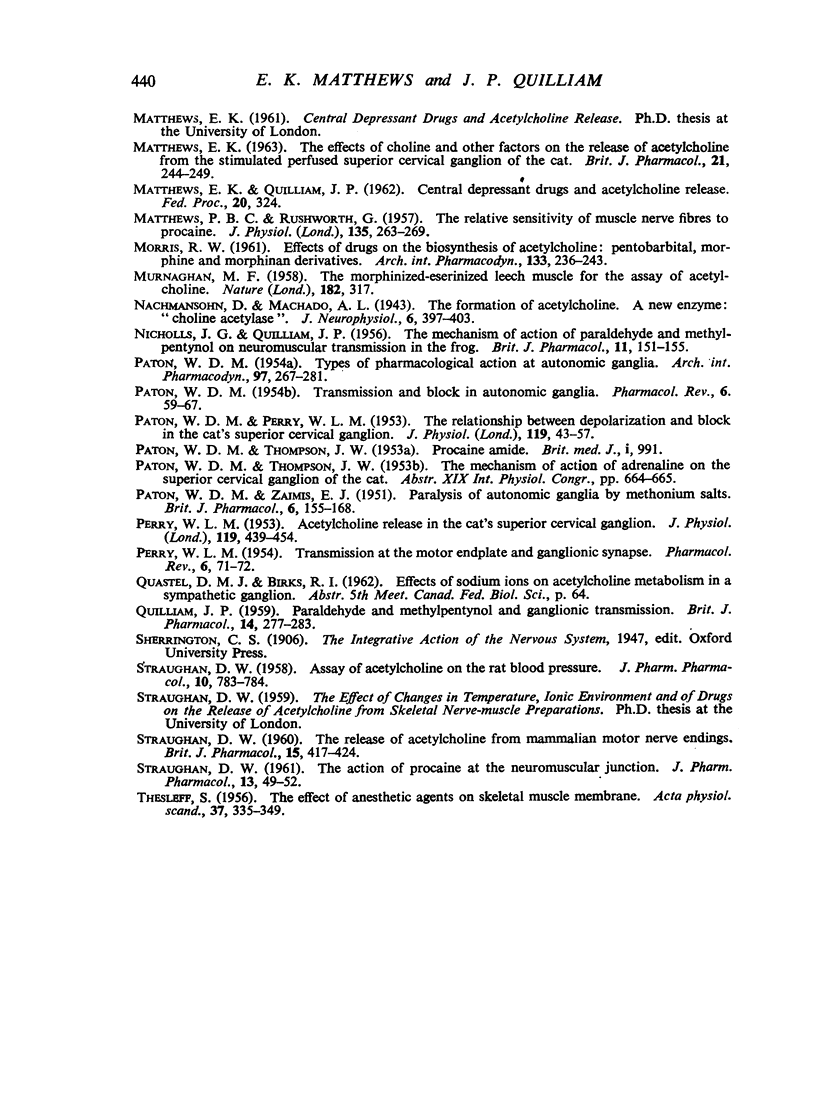
Selected References
These references are in PubMed. This may not be the complete list of references from this article.
- BELL P. M. Stimulator control to provide single shocks alternately to nerve and muscle with faradic stimulation of the nerve at predetermined intervals. J Physiol. 1957 Jun 18;137(1):1–2P. [PubMed] [Google Scholar]
- BIRKS R. I., MACINTOSH F. C., SASTRY P. B. Pharmacological inhibition of acetylcholine synthesis. Nature. 1956 Nov 24;178(4543):1181–1181. doi: 10.1038/1781181a0. [DOI] [PubMed] [Google Scholar]
- BURGEN A. S. V., DICKENS F., ZATMAN L. J. The action of botulinum toxin on the neuro-muscular junction. J Physiol. 1949 Aug;109(1-2):10–24. doi: 10.1113/jphysiol.1949.sp004364. [DOI] [PMC free article] [PubMed] [Google Scholar]
- Bacq Z. M., Brown G. L. Pharmacological experiments on mammalian voluntary muscle, in relation to the theory of chemical transmission. J Physiol. 1937 Feb 19;89(1):45–60. doi: 10.1113/jphysiol.1937.sp003461. [DOI] [PMC free article] [PubMed] [Google Scholar]
- COLLIER B., EXLEY K. A. MECHANISM OF THE ANTAGONISM BY TETRAETHYLAMMONIUM OF NEUROMUSCULAR BLOCK DUE TO D-TUBOCURARINE OR CALCIUM DEFICIENCY. Nature. 1963 Aug 17;199:702–703. doi: 10.1038/199702a0. [DOI] [PubMed] [Google Scholar]
- Cowan S. L., Walter W. G. The effects of tetra-ethylammonium iodide on the electrical response and the accommodation of nerve. J Physiol. 1937 Nov 26;91(2):101–126. doi: 10.1113/jphysiol.1937.sp003547. [DOI] [PMC free article] [PubMed] [Google Scholar]
- DEL CASTILLO J., KATZ B. Biophysical aspects of neuro-muscular transmission. Prog Biophys Biophys Chem. 1956;6:121–170. [PubMed] [Google Scholar]
- ECCLES J. C., RALL W. Effects induced in a monosynaptic reflex path by its activation. J Neurophysiol. 1951 Sep;14(5):353–376. doi: 10.1152/jn.1951.14.5.353. [DOI] [PubMed] [Google Scholar]
- EMMELIN N., MACINTOSH F. C. The release of acetylcholine from perfused sympathetic ganglia and skeletal muscles. J Physiol. 1956 Feb 28;131(2):477–496. doi: 10.1113/jphysiol.1956.sp005477. [DOI] [PMC free article] [PubMed] [Google Scholar]
- EXLEY K. A. Depression of autonomic ganglia by barbiturates. Br J Pharmacol Chemother. 1954 Jun;9(2):170–181. doi: 10.1111/j.1476-5381.1954.tb00837.x. [DOI] [PMC free article] [PubMed] [Google Scholar]
- Feldberg W., Gaddum J. H. The chemical transmitter at synapses in a sympathetic ganglion. J Physiol. 1934 Jun 9;81(3):305–319. doi: 10.1113/jphysiol.1934.sp003137. [DOI] [PMC free article] [PubMed] [Google Scholar]
- Feldberg W., Vartiainen A. Further observations on the physiology and pharmacology of a sympathetic ganglion. J Physiol. 1934 Dec 14;83(1):103–128. doi: 10.1113/jphysiol.1934.sp003214. [DOI] [PMC free article] [PubMed] [Google Scholar]
- GARDINER J. E. The inhibition of acetylcholine synthesis in brain by a hemicholinium. Biochem J. 1961 Nov;81:297–303. doi: 10.1042/bj0810297. [DOI] [PMC free article] [PubMed] [Google Scholar]
- JOHNSON W. J., QUASTEL J. H. Narcotics and biological acetylations. Nature. 1953 Apr 4;171(4353):602–605. doi: 10.1038/171602a0. [DOI] [PubMed] [Google Scholar]
- KOKETSU K. Action of tetraethylammonium chloride on neuromuscular transmission in frogs. Am J Physiol. 1958 Apr;193(1):213–218. doi: 10.1152/ajplegacy.1958.193.1.213. [DOI] [PubMed] [Google Scholar]
- KUMAGAI H., EBASHI S., TAKEDA F. Studies on choline acetylase. I. Jpn J Pharmacol. 1954 Sep;4(1):24–31. doi: 10.1254/jjp.4.24. [DOI] [PubMed] [Google Scholar]
- LARRABEE M. G., POSTERNAK J. M. Selective action of anesthetics on synapses and axons in mammalian sympathetic ganglia. J Neurophysiol. 1952 Mar;15(2):91–114. doi: 10.1152/jn.1952.15.2.91. [DOI] [PubMed] [Google Scholar]
- LLOYD D. P. C. Post-tetanic potentiation of response in monosynaptic reflex pathways of the spinal cord. J Gen Physiol. 1949 Nov;33(2):147–170. doi: 10.1085/jgp.33.2.147. [DOI] [PMC free article] [PubMed] [Google Scholar]
- MARLEY E., PATON W. D. The effect of methylpentynol and methylpentynol carbamate on the perfused superior cervical ganglion of the cat. Br J Pharmacol Chemother. 1959 Jun;14(2):303–306. doi: 10.1111/j.1476-5381.1959.tb01401.x. [DOI] [PMC free article] [PubMed] [Google Scholar]
- MARSHALL E. K., Jr, OWENS A. H., Jr Absorption, excretion and metabolic fate of chloral hydrate and trichloroethanol. Bull Johns Hopkins Hosp. 1954 Jul;95(1):1–18. [PubMed] [Google Scholar]
- MATTHEWS E. K. THE EFFECTS OF CHOLINE AND OTHER FACTORS ON THE RELEASE OF ACETYLCHOLINE FROM THE STIMULATED PERFUSED SUPERIOR CERVICAL GANGLION OF THE CAT. Br J Pharmacol Chemother. 1963 Oct;21:244–249. doi: 10.1111/j.1476-5381.1963.tb01523.x. [DOI] [PMC free article] [PubMed] [Google Scholar]
- MATTHEWS P. B., RUSHWORTH G. The relative sensitivity of muscle nerve fibres to procaine. J Physiol. 1957 Feb 15;135(2):263–269. doi: 10.1113/jphysiol.1957.sp005708. [DOI] [PMC free article] [PubMed] [Google Scholar]
- MORRIS R. W. Effects of drugs on the biosynthesis of acetylcholine: pentobarbital, morphine and morphinan derivatives. Arch Int Pharmacodyn Ther. 1961 Aug-Sep;133:236–243. [PubMed] [Google Scholar]
- MURNAGHAN M. F. The morphinizedeserinized leech muscle for the assay of acetylcholine. Nature. 1958 Aug 2;182(4631):317–317. doi: 10.1038/182317a0. [DOI] [PubMed] [Google Scholar]
- Macintosh F. C. Liberation of acetylcholine by the perfused superior cervical ganglion. J Physiol. 1938 Oct 14;94(1):155–169. doi: 10.1113/jphysiol.1938.sp003670. [DOI] [PMC free article] [PubMed] [Google Scholar]
- McLENNAN H., ELLIOTT K. A. C. Effects of convulsant and narcotic drugs on acetylcholine synthesis. J Pharmacol Exp Ther. 1951 Sep;103(1):35–43. [PubMed] [Google Scholar]
- NICHOLLS J. G., QUILLIAM J. P. The mechanism of action of paraldehyde and methylpentynol on neuromuscular transmission in the frog. Br J Pharmacol Chemother. 1956 Jun;11(2):151–155. doi: 10.1111/j.1476-5381.1956.tb01045.x. [DOI] [PMC free article] [PubMed] [Google Scholar]
- PATON W. D. M., PERRY W. L. M. The relationship between depolarization and block in the cat's superior cervical ganglion. J Physiol. 1953 Jan;119(1):43–57. doi: 10.1113/jphysiol.1953.sp004827. [DOI] [PMC free article] [PubMed] [Google Scholar]
- PATON W. D. M., ZAIMIS E. J. Paralysis of autonomic ganglia by methonium salts. Br J Pharmacol Chemother. 1951 Mar;6(1):155–168. doi: 10.1111/j.1476-5381.1951.tb00631.x. [DOI] [PMC free article] [PubMed] [Google Scholar]
- PATON W. D. Transmission and block in autonomic ganglia. Pharmacol Rev. 1954 Mar;6(1):59–67. [PubMed] [Google Scholar]
- PATON W. D. Types of pharmacological action at autonomic ganglia. Arch Int Pharmacodyn Ther. 1954 Apr 1;97(3-4):267–281. [PubMed] [Google Scholar]
- PERRY W. L. M. Acetylcholine release in the cat's superior cervical ganglion. J Physiol. 1953 Mar;119(4):439–454. doi: 10.1113/jphysiol.1953.sp004858. [DOI] [PMC free article] [PubMed] [Google Scholar]
- PERRY W. L. Transmission at the motor endplate and ganglionic synapse. Pharmacol Rev. 1954 Mar;6(1):71–72. [PubMed] [Google Scholar]
- QUILLIAM J. P. Paraldehyde and methylpentynol and ganglionic transmission. Br J Pharmacol Chemother. 1959 Jun;14(2):277–283. doi: 10.1111/j.1476-5381.1959.tb01399.x. [DOI] [PMC free article] [PubMed] [Google Scholar]
- STRAUGHAN D. W. Assay of acetylcholine on the rat blood pressure. J Pharm Pharmacol. 1958 Dec;10(12):783–784. doi: 10.1111/j.2042-7158.1958.tb10376.x. [DOI] [PubMed] [Google Scholar]
- THESLEFF S. The effect of anesthetic agents on skeletal muscle membrane. Acta Physiol Scand. 1956 Nov 5;37(4):335–349. doi: 10.1111/j.1748-1716.1956.tb01369.x. [DOI] [PubMed] [Google Scholar]


